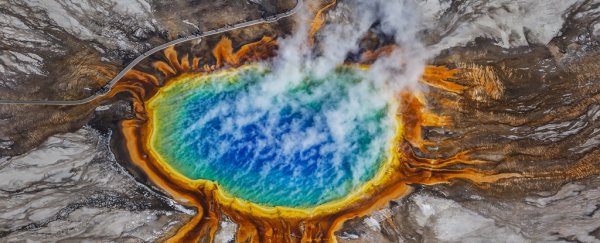It's the prettiest powder keg on the planet - the Yellowstone supervolcano, simmering under the mystique and grandeur of the national park that adorns the fearsome caldera. And scientists just got one step closer to understanding the hidden geology of this epic blowhole.
Using supercomputers to model the behaviour of two known magma chambers concealed below the surface of Yellowstone, scientists have identified a 'transition zone' where the magma bodies almost meet.
Here, they form a vast slab of solidified, pressure-trapping rock that could be what fuels the supervolcano's hellish explosions.
"We think that this structure is what causes the rhyolite-basalt volcanism throughout the Yellowstone hotspot, including supervolcanic eruptions," says geologist Ilya Bindeman from the University of Oregon.
"This is the nursery, a geological and petrological match with eruptive products."
 The mid-crustal sill that separates magma under Yellowstone (Dylan Colon)
The mid-crustal sill that separates magma under Yellowstone (Dylan Colon)
Bindeman and his team detected this naturally occurring munitions dump underground by running simulations based on recent research from scientists at the University of Utah, who used seismic imaging to detect not just one but two gargantuan magma chambers buried within the crust of Yellowstone caldera.
To investigate how these dual chambers of molten rock came to be – and to try to understand the magma transfer relationship between them – Bindeman and colleagues ran computer simulations tracing Yellowstone's hypothetical evolution over 7 million years, to see how these disparate chambers might form.
The numbers suggest the seismic readings aren't wrong, with repeated simulations producing two magma chambers, separated by a transition zone made up of what's called a mid-crustal sill composed of cooler magma, which is sandwiched between the hotter, more viscous reservoirs.
Per the modelling, this rock shelf is located about 10 kilometres (6.2 miles) below the surface of Yellowstone, and is between 10 to 15 kilometres (9.3 miles) thick.
The sill is composed of solidified gabbro, a rock formed from cooled magma, and the researchers say it's possible the same phenomenon forms in other supervolcanoes around the world.
Due to the simulated basis of the study, we can only hypothesise about the mid-crustal sill's existence for now, but given the data confirm seismic observations of the caldera, the team thinks their findings offer the first glimpse of how magma distributes itself inside the supervolcano.
While these insights don't necessarily tell us any more about how or when Yellowstone might next erupt, it does bring us closer to that kind of understanding – and when we're talking about an event that could choke the planet in a catastrophic volcanic winter, that's some pretty important stuff to know.
The findings are reported in Geophysical Research Letters.
